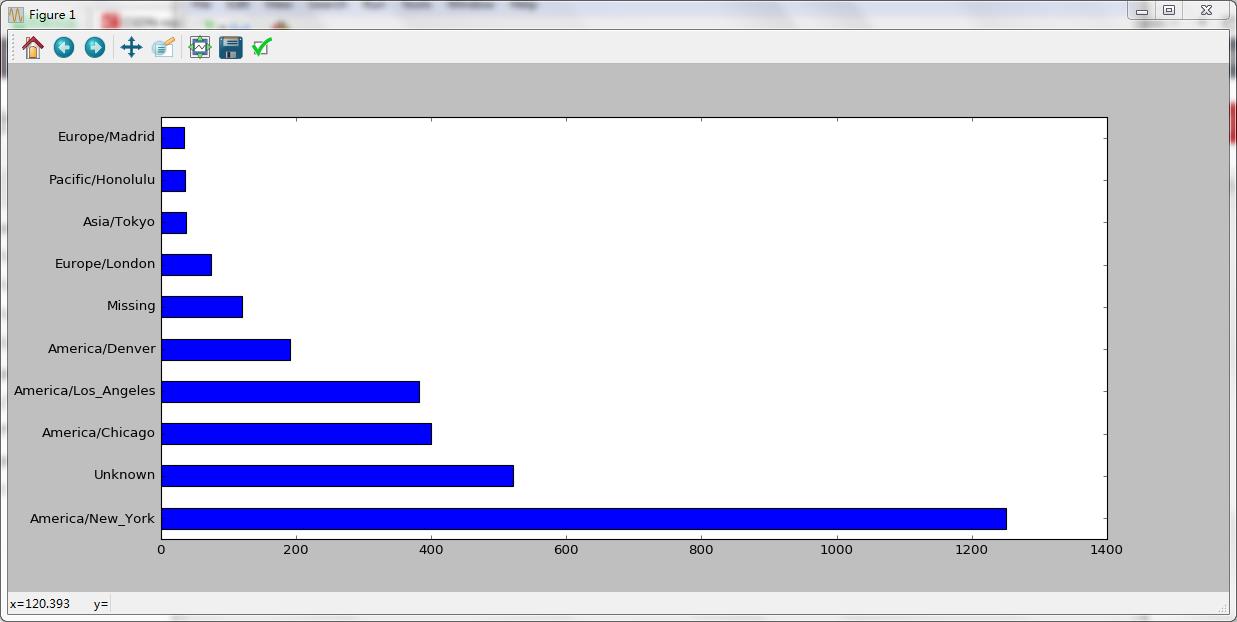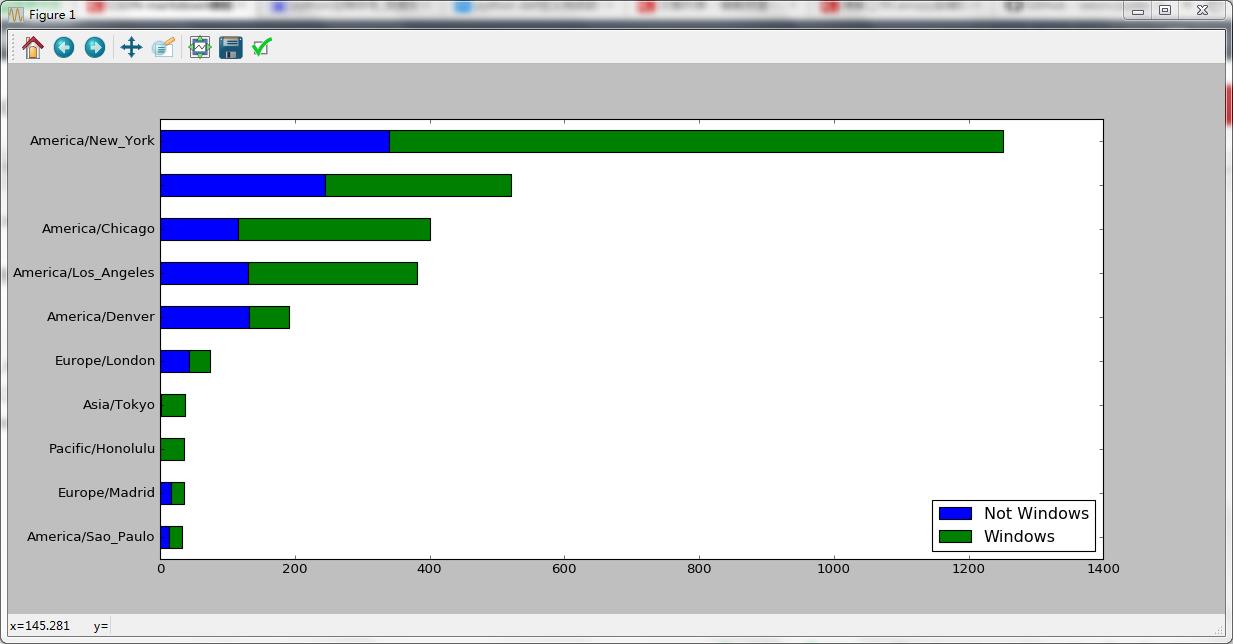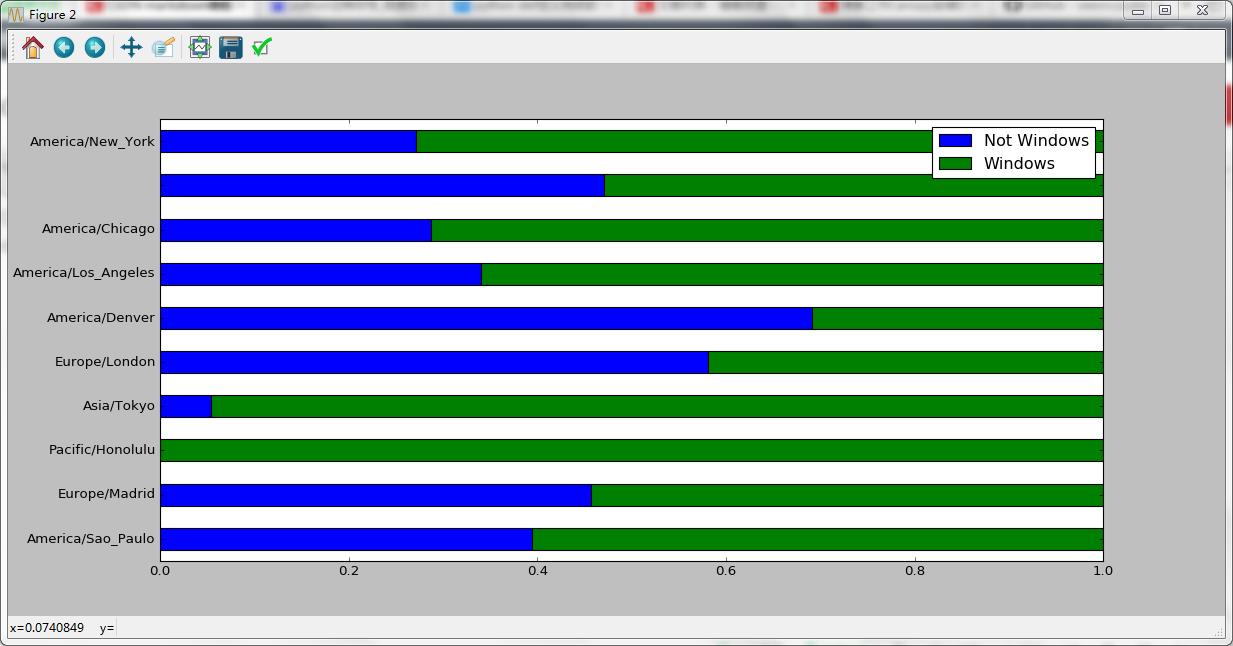说明:本文章为Python数据处理学习日志,主要内容来自书本《利用Python进行数据分析》,Wes McKinney著,机械工业出版社。
“以我的观点来看,如果只需要用Python进行高效的数据分析工作,根本就没必要非得成为通用软件编程方面的专家不可。”——作者
接下来是书本一些代码的实现,用来初步了解Python处理数据的功能,相关资源可在下方链接下载。
书本相关资源
读取文件第一行
相关例子可以再shell中执行,也可以再Canopy Editor中执行。以下代码在Canopy Editor中执行。
path='E:\\Enthought\\book\\ch02\\usagov_bitly_data2012-03-16-1331923249.txt'
open(path).readline()在shell中执行则不要转置符’\’,path为存放文件路径。在shell中执行一定要用pylab模式打开,不然绘图会出现些小问题。
path='E:\Enthought\book\ch02\usagov_bitly_data2012-03-16-1331923249.txt'输出结果:
Out[2]: '{ "a": "Mozilla\\/5.0 (Windows NT 6.1; WOW64) AppleWebKit\\/535.11 (KHTML, like Gecko) Chrome\\/17.0.963.78 Safari\\/535.11", "c": "US", "nk": 1, "tz": "America\\/New_York", "gr": "MA", "g": "A6qOVH", "h": "wfLQtf", "l": "orofrog", "al": "en-US,en;q=0.8", "hh": "1.usa.gov", "r": "http:\\/\\/www.facebook.com\\/l\\/7AQEFzjSi\\/1.usa.gov\\/wfLQtf", "u": "http:\\/\\/www.ncbi.nlm.nih.gov\\/pubmed\\/22415991", "t": 1331923247, "hc": 1331822918, "cy": "Danvers", "ll": [ 42.576698, -70.954903 ] }\n'以上结果为纯文本加载。
Python中的内置或者第三方模块将JSON字符串转化为Python字典对象。这里,将使用json模块及其loads函数逐行加载已经下载好的数据文件:
import json
path='E:\\Enthought\\book\\ch02\\usagov_bitly_data2012-03-16-1331923249.txt'
records=[json.loads(line) for line in open(path)]
records[0]这样,records对象就成了一组Python字典了。
Out[6]:
{u'a': u'Mozilla/5.0 (Windows NT 6.1; WOW64) AppleWebKit/535.11 (KHTML, like Gecko) Chrome/17.0.963.78 Safari/535.11',
u'al': u'en-US,en;q=0.8',
u'c': u'US',
u'cy': u'Danvers',
u'g': u'A6qOVH',
u'gr': u'MA',
u'h': u'wfLQtf',
u'hc': 1331822918,
u'hh': u'1.usa.gov',
u'l': u'orofrog',
u'll': [42.576698, -70.954903],
u'nk': 1,
u'r': u'http://www.facebook.com/l/7AQEFzjSi/1.usa.gov/wfLQtf',
u't': 1331923247,
u'tz': u'America/New_York',
u'u': u'http://www.ncbi.nlm.nih.gov/pubmed/22415991'}现在,只要一字符串形式给出想要访问的键就可以得到当前记录中相应的值了:
records[0]['tz']
Out[7]: u'America/New_York'
print records[0]['tz']
America/New_York对时区进行计数
1.用纯Python对时区进行计数
假设我们想知道该数据集中最常出现的是哪个时区(即tz字段)。首先,我们用列表推导式取出一组时区:
time_zones=[rec['tz'] for rec in records if 'tz' in rec]
time_zones[:10] #获取前10条记录的tz结果:
Out[12]:
[u'America/New_York',
u'America/Denver',
u'America/New_York',
u'America/Sao_Paulo',
u'America/New_York',
u'America/New_York',
u'Europe/Warsaw',
u'',
u'',
u'']接下来对时区进行计数:
def get_counts(sequence):
counts={}
for x in sequence:
if x in counts:
counts[x]+=1
else:
counts[x]=1
return counts或者使用Python标准库
def get_counts2(sequence):
counts=defaultdict(int) #所有初始值均会初始化为0
for x in sequence:
counts[x]+=1
return counts调用函数
counts = get_counts(time_zones)
counts['America/New_York']
Out[20]: 1251
len(time_zones)
Out[21]: 3440如果只想要得到前10位的时区及其计数值,我们需要用到一些关羽字典的处理技巧:
def top_counts(count_dict,n=10):
value_key_pairs=[(count,tz) for tz,count in count_dict.items()]
value_key_pairs.sort()
return value_key_pairs[-n:]数据处理结果
top_counts(counts)
Out[26]:
[(33, u'America/Sao_Paulo'),
(35, u'Europe/Madrid'),
(36, u'Pacific/Honolulu'),
(37, u'Asia/Tokyo'),
(74, u'Europe/London'),
(191, u'America/Denver'),
(382, u'America/Los_Angeles'),
(400, u'America/Chicago'),
(521, u''),
(1251, u'America/New_York')]或者在Python标准库中找到collections.Counter类,处理起来就比较简单:
from collections import Counter
counts=Counter(time_zones)
counts.most_common(10)
Out[29]:
[(u'America/New_York', 1251),
(u'', 521),
(u'America/Chicago', 400),
(u'America/Los_Angeles', 382),
(u'America/Denver', 191),
(u'Europe/London', 74),
(u'Asia/Tokyo', 37),
(u'Pacific/Honolulu', 36),
(u'Europe/Madrid', 35),
(u'America/Sao_Paulo', 33)]2.用pandas对时区进行计数
DataFrame是pandas中重要的数据结构,它用于将数据表示成一个表格。
from pandas import DataFrame,Series
import pandas as pd;import numpy as np
frame = DataFrame(records)结果
frame['tz'][:10]
Out[34]:
0 America/New_York
1 America/Denver
2 America/New_York
3 America/Sao_Paulo
4 America/New_York
5 America/New_York
6 Europe/Warsaw
7
8
9
Name: tz, dtype: objectframe[‘tz’]所返回的Series对象有一个value_counts方法,该方法可以让我们得到所需要的信息:
tz_counts = frame['tz'].value_counts()
tz_counts[:10]
Out[36]:
America/New_York 1251
521
America/Chicago 400
America/Los_Angeles 382
America/Denver 191
Europe/London 74
Asia/Tokyo 37
Pacific/Honolulu 36
Europe/Madrid 35
America/Sao_Paulo 33
Name: tz, dtype: int64绘图
然后,我们可以利用绘图库(即matplotlib)为该段数据生成一张图片。为此,我们先给记录中位未知或者缺失的时区填上一个替代值。fillna函数可以替换缺失值(NA),而未知值(空字符串)则可以通过布尔型数组索引加以替换:
clean_tz=frame['tz'].fillna('Missing')
clean_tz[clean_tz==''] = 'Unknown'
tz_counts=clean_tz.value_counts()
tz_counts[:10]
Out[41]:
America/New_York 1251
Unknown 521
America/Chicago 400
America/Los_Angeles 382
America/Denver 191
Missing 120
Europe/London 74
Asia/Tokyo 37
Pacific/Honolulu 36
Europe/Madrid 35
Name: tz, dtype: int64绘图
tz_counts[:10].plot(kind='barh',rot=0)
Out[42]: <matplotlib.axes._subplots.AxesSubplot at 0xe50b1d0>结果
对Agent(‘a’)进行划分
‘a’字段含有执行URL缩短操作的浏览器、设备、应用程序的相关信息:
frame['a'][0]
Out[43]: u'Mozilla/5.0 (Windows NT 6.1; WOW64) AppleWebKit/535.11 (KHTML, like Gecko) Chrome/17.0.963.78 Safari/535.11'运用Python内置的字符串函数和正则表达式,可以将这种字符串的第一节(与浏览器大致对应)分离出来并得到另外一份用户行为摘要:
results = Series([x.split()[0] for x in frame.a.dropna()]) #按空格切分字段'a'
results[:5]
Out[45]:
0 Mozilla/5.0
1 GoogleMaps/RochesterNY
2 Mozilla/4.0
3 Mozilla/5.0
4 Mozilla/5.0
dtype: object
results.value_counts()[:8]
Out[46]:
Mozilla/5.0 2594
Mozilla/4.0 601
GoogleMaps/RochesterNY 121
Opera/9.80 34
TEST_INTERNET_AGENT 24
GoogleProducer 21
Mozilla/6.0 5
BlackBerry8520/5.0.0.681 4
dtype: int64现在,根据Windows用户和非Windows用户对时区统计信息进行分解。为了方便起见,嘉定只要agent字符串中含有“Windows”就认为该用户为Windows用户。
cframe = frame[frame.a.notnull()] #删除agent为空的记录
operating_system = np.where(cframe['a'].str.contains('Windows'),'Windows','Not Windows')
operating_system[:5]
Out[52]: #可能是版本原因,此处略有不同,原书以frame形式输出
array(['Windows', 'Not Windows', 'Windows', 'Not Windows', 'Windows'],
dtype='|S11')接下来就可以根据时区和新得到的操作系统列表对数据进行分组,然后通过size对分组结果进行计数(类似于上面的value_counts函数),并利用unstack对技术结果进行重塑:
by_tz_os = cframe.groupby(['tz',operating_system])
agg_counts = by_tz_os.size().unstack().fillna(0)
agg_counts[:10]
Out[56]:
Not Windows Windows
tz
245.0 276.0
Africa/Cairo 0.0 3.0
Africa/Casablanca 0.0 1.0
Africa/Ceuta 0.0 2.0
Africa/Johannesburg 0.0 1.0
Africa/Lusaka 0.0 1.0
America/Anchorage 4.0 1.0
America/Argentina/Buenos_Aires 1.0 0.0
America/Argentina/Cordoba 0.0 1.0
America/Argentina/Mendoza 0.0 1.0最后,选出最常出现的时区。根据agg_counts中的行数构造一个间接索引数组:
indexer = agg_counts.sum(1).argsort()
indexer[:10]
Out[58]:
tz
24
Africa/Cairo 20
Africa/Casablanca 21
Africa/Ceuta 92
Africa/Johannesburg 87
Africa/Lusaka 53
America/Anchorage 54
America/Argentina/Buenos_Aires 57
America/Argentina/Cordoba 26
America/Argentina/Mendoza 55
dtype: int64然后通过take按照这个顺序截取最后10行:
count_subset = agg_counts.take(indexer)[-10:]
count_subset
Out[60]:
Not Windows Windows
tz
America/Sao_Paulo 13.0 20.0
Europe/Madrid 16.0 19.0
Pacific/Honolulu 0.0 36.0
Asia/Tokyo 2.0 35.0
Europe/London 43.0 31.0
America/Denver 132.0 59.0
America/Los_Angeles 130.0 252.0
America/Chicago 115.0 285.0
245.0 276.0
America/New_York 339.0 912.0生成图形
count_subset.plot(kind='barh',stacked=True)
Out[61]: <matplotlib.axes._subplots.AxesSubplot at 0xeb89d68>结果
为了看清楚小分组中Windows用户的相对比例,可以将各行规范化为“总计为1”并重新绘图:
normed_subset = count_subset.div(count_subset.sum(1),axis=0)
normed_subset.plot(kind='barh',stacked=True)
Out[63]: <matplotlib.axes._subplots.AxesSubplot at 0xed1e1d0>结果

























 4073
4073











 被折叠的 条评论
为什么被折叠?
被折叠的 条评论
为什么被折叠?








